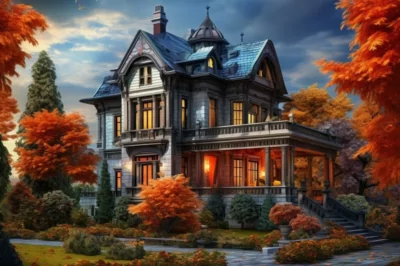
Most Popular Dark Tourism Destinations Around the World: Exploring the Dark Side
Dark tourism is a travel trend that has gained popularity in recent years. This type of tourism involves visits to places that have witnessed dark and tragic events in history. There are many dark tourism destinations around the world, from concentration camps to genocide memorials, from natural disaster sites to war zones.
But why do people choose to visit these places? What are the most popular dark tourism destinations and what do they tell us? In this article, we will take a journey into the world of dark tourism and explore the most popular tourism destinations.
What is Dark Tourism?
Dark tourism is a type of tourism that involves traveling to places associated with death, suffering or violence. Dark tourist destinations can include battlefields, cemeteries, natural disaster zones and areas associated with political violence. The term “dark tourism” was first coined by academic John Lennon in 1996 and has attracted increasing academic interest in recent years.
The different types of dark tourism: There are many different types of dark tourism destinations. Here are some of the most popular ones:
- Historical sites associated with death and tragedy: These places include battlefields, cemeteries and other places where large numbers of people have died.
- Places associated with natural disasters: These places may include areas devastated by hurricanes, earthquakes or other natural disasters.
- Places associated with crime and violence: These places include prisons, gang territories and other places where people have been killed or harmed.
- Haunted places: These include places such as houses, hotels, cemeteries, etc. that are associated with ghosts or other supernatural beings.
- Nuclear disaster sites: These places include Chernobyl, Fukushima and other places affected by nuclear accidents.
Most Popular Dark Tourism Destinations
Some travelers prefer destinations that offer a glimpse into the dark side of humanity. These “dark tourism” destinations can be found all over the world and offer a unique and often shocking glimpse into history.
From concentration camps to genocide museums, many dark tourism destinations offer a shocking look at the worst moments in human history. If you want to explore the dark side of our world, here are some dark tourism destinations to consider:
1986 Chernobyl Nuclear Disaster, Ukraina
The 1986 Chernobyl nuclear disaster was one of the worst man-made disasters in history. The explosion at the Chernobyl Nuclear Power Plant released large amounts of radiation into the environment and contaminated the surrounding area with dangerous levels of radiation. Thousands of people were evacuated from their homes and many were exposed to high levels of radiation.

Today, the Chernobyl Forbidden Zone is a popular dark tourism destination. Visitors can tour the abandoned city of Pripyat, see the reactors up close and learn about the terrible event that happened there. While Chernobyl is safe to visit today, it is still an eerie and thought-provoking place, a reminder of the devastation that nuclear accidents can cause.
World’s First Nuclear Bombing Hiroshima, Japan
Hiroshima, Japan is known as the site of the world’s first nuclear bombing. On August 6, 1945, the American B-29 bomber Enola Gay dropped an atomic bomb on the city, killing tens of thousands of people instantly and causing massive destruction.

Today, Hiroshima is a city of peace, with a vibrant culture. However, the city has many monuments and museums dedicated to the bombing and its aftermath. Visitors to dark tourism can learn about the history of the atomic bomb at the Hiroshima Peace Memorial Museum, see the remains of destroyed buildings at the Atomic Bomb Dome, or pay their respects at the Hiroshima Peace Memorial Park.
Berlin Wall, Germany: The Wall Separated Families
The Berlin Wall was a physical barrier built by East Germany (GDR) to prevent movement between West and East Berlin. It was built in 1961 and demolished in 1989. The wall separated families, friends and loved ones for 28 years.

Today, the Berlin Wall is one of the most popular dark tourism destinations in the world. Visitors can see the places where the wall once stood and visit monuments and museums dedicated to its history.
Ancient City of Pompeii, Italy: The City Destroyed by a Volcano Eruption
Pompeii is one of the world’s most popular dark tourism destinations. Every year thousands of people visit the ancient city to see the ruins of Pompeii, which was destroyed by a volcano eruption in 79. Pompeii offers a rare glimpse into life in Roman times.

The ruins are incredibly well preserved and many things can be seen, such as houses, public buildings and even some preserved bodies. If you are interested in dark tourism, Pompeii is definitely a place to add to your list.
Auschwitz Concentration Camps, Germany
Auschwitz was the largest of the Nazi concentration camps and consisted of three main camps – Auschwitz I, Auschwitz II-Birkenau and Auschwitz III-Monowitz – and 45 sub-camps. Most of the victims were Jewish, but Poles and Roma were also murdered. Auschwitz I was the original camp, established in 1940, and included barracks for prisoners and a gas chamber. The gas chamber was not used extensively in this camp.

Auschwitz II-Birkenau was the main extermination camp built in 1941, where most of the Jews killed at Auschwitz were sent. The gas chambers at Birkenau could kill 2,000 people at a time. Auschwitz III-Monowitz was a forced labor camp opened in 1942. Prisoners in this camp worked in factories for companies such as I.G. Farben and Krupp.
What to Expect at Dark Tourism Destinations?
When traveling to dark tourism destinations, it is important to know what to expect. These places can be emotionally challenging and it is important to be prepared for the experience.
- You will probably feel many emotions such as sadness, anger and disbelief.
- You may feel overwhelmed or triggered by past traumas.
- It is important to allow time and space to process these emotions.
- Many dark tourism destinations can be quite crowded, so be prepared for large crowds.
- You may see and hear graphic images and disturbing stories. This can also be overwhelming, so watch yourself.
- Security guards or other staff may be present on site. This is for your safety and for the protection of the site.
- Some places may have dress codes or special rules about behavior. You should follow these rules out of respect for the site and for those who lost their lives there.
FAQs
Is dark tourism ethical?
There are many different views on whether dark tourism is ethical. Some people think that dark tourism is exploiting the suffering of others for profit. Others argue that dark tourism can be educational and raise awareness about important historical events.
Popular dark tourism destinations include concentration camps, genocide memorials and sites associated with natural disasters. Critics say these sites should be treated with respect and dignity and not turned into tourist attractions. Supporters of dark tourism argue that such sites can help people understand and empathize with the victims of these events.
Conclusion
Dark tourism helps us understand and remember the most painful and dark moments of our history. These places teach us important lessons of human history and allow us to empathize.
If you are looking for an extraordinary trip and want to delve deeper into history, consider visiting dark tourism destinations. These experiences will give you a perspective that will impact both you and future generations.







